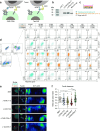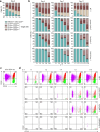CD22 CAR-T cells secreting CD19 T-cell engagers for improved control of B-cell acute lymphoblastic leukemia progression
- PMID: 40306957
- PMCID: PMC12049870
- DOI: 10.1136/jitc-2024-009048
CD22 CAR-T cells secreting CD19 T-cell engagers for improved control of B-cell acute lymphoblastic leukemia progression
Abstract
Background: CD19-directed cancer immunotherapies, based on engineered T cells bearing chimeric antigen receptors (CARs, CAR-T cells) or the systemic administration of bispecific T cell-engaging (TCE) antibodies, have shown impressive clinical responses in relapsed/refractory B-cell acute lymphoblastic leukemia (B-ALL). However, more than half of patients relapse after CAR-T or TCE therapy, with antigen escape or lineage switching accounting for one-third of disease recurrences. To minimize tumor escape, dual-targeting CAR-T cell therapies simultaneously targeting CD19 and CD22 have been developed and validated both preclinically and clinically.
Methods: We have generated the first dual-targeting strategy for B-cell malignancies based on CD22 CAR-T cells secreting an anti-CD19 TCE antibody (CAR-STAb-T) and conducted a comprehensive preclinical characterization comparing its therapeutic potential in B-ALL with that of previously validated dual-targeting CD19/CD22 tandem CAR cells (TanCAR-T cells) and co-administration of two single-targeting CD19 and CD22 CAR-T cells (pooled CAR-T cells).
Results: We demonstrate that CAR-STAb-T cells efficiently redirect bystander T cells, resulting in higher cytotoxicity of B-ALL cells than dual-targeting CAR-T cells at limiting effector:target ratios. Furthermore, when antigen loss was replicated in a heterogeneous B-ALL cell model, CAR-STAb T cells induced more potent and effective cytotoxic responses than dual-targeting CAR-T cells in both short- and long-term co-culture assays, reducing the risk of CD19-positive leukemia escape. In vivo, CAR-STAb-T cells also controlled leukemia progression more efficiently than dual-targeting CAR-T cells in patient-derived xenograft mouse models under T cell-limiting conditions.
Conclusions: CD22 CAR-T cells secreting CD19 T-cell engagers show an enhanced control of B-ALL progression compared with CD19/CD22 dual CAR-based therapies, supporting their potential for clinical testing.
Keywords: Adoptive cell therapy - ACT; Bispecific T cell engager - BiTE; Chimeric antigen receptor - CAR; Hematologic Malignancies; Immunotherapy.
© Author(s) (or their employer(s)) 2025. Re-use permitted under CC BY-NC. No commercial re-use. See rights and permissions. Published by BMJ Group.
Conflict of interest statement
Competing interests: LA-V is a cofounder of Leadartis, a spin-off company focused on unrelated interests. LA-V and BB are cofounders of STAb Therapeutics, a spin-off company from the Research Institute Hospital 12 de Octubre (imas12). PM is cofounder of OneChain Immunotherapeutics, a spin-off company from the Josep Carreras Leukemia Research Institute.
Figures





References
-
- Westin JR, Kersten MJ, Salles G, et al. Efficacy and safety of CD19-directed CAR-T cell therapies in patients with relapsed/refractory aggressive B-cell lymphomas: Observations from the JULIET, ZUMA-1, and TRANSCEND trials. Am J Hematol. 2021;96:1295–312. doi: 10.1002/ajh.26301. - DOI - PMC - PubMed
MeSH terms
Substances
LinkOut - more resources
Full Text Sources
